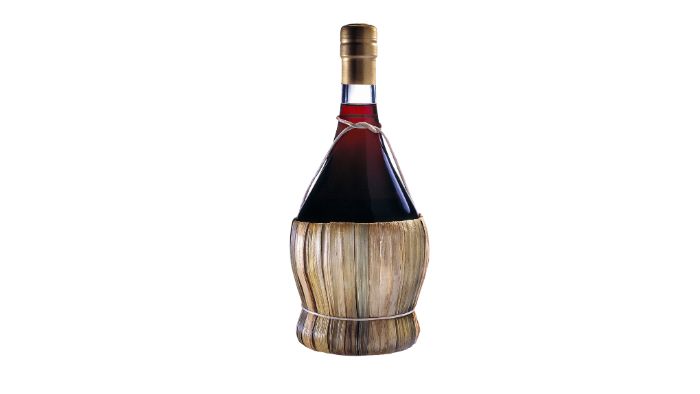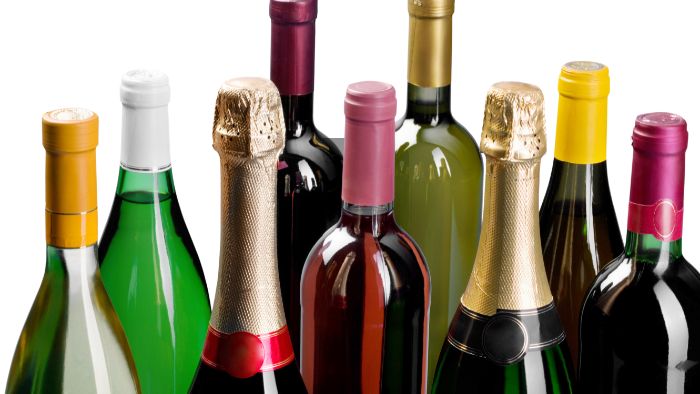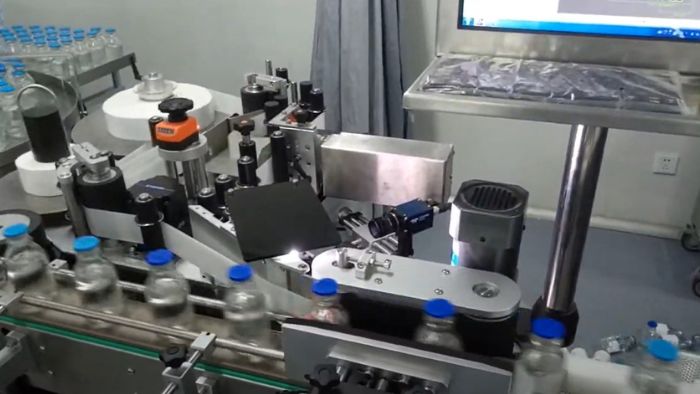When considering bottle label size for your new product, several factors come into play – including the size of the bottle, the usable space, and the number of labels required. You also need to account for small inconsistencies in printing and labeling.
Here’s what to think about when determining product label sizes for bottles:
How should I position labels on my bottles?
Determining the ideal bottle label size and placement for round bottles can be challenging, particularly since pressure-sensitive labels tend to wrinkle when applied to curved surfaces. However, they can be effectively applied to tapered surfaces if the labels are specifically designed with this shape in mind.
For instance, when applying a label to the tapered neck of a beer bottle, the top of the label should be narrower than the bottom to conform to the shape. While the bodies of glass bottles generally feature flat surfaces, plastic bottles often possess a slight taper to facilitate their release from molds. This angle, albeit only a few degrees, can pose significant issues if not accounted for during the label design process.
Most bottles have a flat body, providing ample space for applying a single wrap-around label or separate front and back labels. Even bottles with more complex shapes usually feature a large flat or tapered surface that accommodates pressure-sensitive labels.
For example, the top half of a Chianti bottle is slanted with a curved bottom. Here, you can only apply a pressure-sensitive label around the top half. Although this limits the labeling area, it is not particularly noticeable if the bottle is placed in a traditional basket.

Furthermore, it’s crucial to consider the label material and adhesive properties to ensure they suit the bottle’s surface and curvature. Designing around these characteristics helps avoid common pitfalls such as wrinkling and poor adhesion, ensuring the labels remain aesthetically pleasing and functional.
Bottle label sizes for wine bottles explained
Understanding the right bottle label size for your wine bottles is crucial for creating a professional look. Here are the maximum heights for wine labels based on the five most common bottle sizes:
Champagne – 4 inches: The elegant and festive Champagne bottles often require labels that fit snugly around their curved shape. Labels should not exceed 4 inches in height to maintain a clean look.
Alsace, Burgundy, and Rhone – 4 ½ inches: These bottles, known for their distinctive regional wines, typically need labels that are slightly taller. The maximum height for these is 4 ½ inches to accommodate their slender profiles.
Bordeaux – 6 ½ inches: Bordeaux bottles, known for their robust red wines, have more surface area. Labels for these bottles can be up to 6 ½ inches in height, allowing more space for detailed information and branding.
Common wine bottle label sizes include 3.5 x 4 inches, 4 x 4 inches, 5 x 5 inches, and 4 x 6 inches. For half bottles (375 mL), the standard label size is around 3 1/8 x 2 ¼ inches. These sizes are readily available from label printers. Other sizes may need to be custom-cut to fit your application.

In addition to these, magnum bottles often use labels that are around 5 x 7 inches, while Jeroboam bottles can require even larger labels, typically around 6 x 8 inches. These additional sizes ensure that no matter the bottle size, there’s a suitable label that can be printed and customized for your needs.
Craft soda and beer bottle label sizes
Understanding the correct bottle label size is essential for craft soda and beer bottling, ensuring that your product looks professional and appealing. Of the many bottle designs used in the industry today, only about half see regular use.
For 12 oz. servings of beer and craft sodas, there are 3 primary bottle styles: long-neck bottles, heritage bottles, and stubby bottles. Long-neck bottles, also known as Industry Standard Bottles (ISBs), are the most popular due to their classic look. Heritage bottles are slightly larger with shorter necks, while stubby bottles are wider with almost no neck at all. Despite their varied shapes, all three bottle styles can accommodate a 3 ¾ x 8 1/8 inch label.
Belgian bottles, often used for specialty brews, feature flip tops and hold 375 mL or 12.7 ounces. Bombers, or large format bottles, are typically reserved for limited-release beers and hold 22 ounces. Both types of bottles have enough surface area for a 5 x 8-inch label.
Additionally, the industry has several names for 32-ounce bottles, such as “mini growlers,” “grumblers,” “howlers,” and “growlettes.” These bottles provide sufficient space for a 4 x 6-inch label. Full-size growlers, which hold 64 ounces, offer a larger surface for labeling, fitting a 4 x 7-inch label comfortably.
Moreover, there are other unique bottle sizes and shapes in the craft beverage world. For example, sleek bottles often used for cider can typically fit a 3 x 5-inch label, while certain artisanal soda bottles may require custom-cut labels to match their unique contours. Ensuring that the label fits perfectly on the bottle is key to maintaining a polished and professional appearance for your craft beverages.
Selecting the right label size for spirit bottles
When it comes to spirit bottles, there are numerous options to consider. For the typical rectangular 750 mL bottle, the most common label sizes are either a single 4 x 6-inch wrap-around label or a pair of 3 ½ x 4 ¾ inch labels for the front and back of the bottle.
Steps to measure bottles and design a label mockup
While there are standard bottle and label sizes, you may encounter slight dimensional differences between models. If you want to use a less common shape to help your products stand out on the shelf, it’s essential to figure out what works best for coverage and availability.
Fortunately, it’s easy to take a few measurements or build a quick mockup of your label. All you need is flexible tape or ruler, like a tailor’s measuring tape, along with a pen or pencil, some paper, and a pair of scissors. With these tools, you can quickly draft your label design.
First, use a tape measure to determine the height and circumference of the bottle’s body. Transfer these measurements to the paper, then cut the paper to your desired shape. When creating your label, it’s important to add a 1/8-1/4 inch gap between the label and the edges of the bottle. This allowance provides leeway for slight imperfections in the bottle shape, the labels, or the application process.
Wrap the paper around the bottle and see how it fits. Trim the label as needed to achieve a perfect fit. If you notice the mockup wants to skew, your bottles may have slight taper or shape imperfections. Be sure to bring this up with your label manufacturer to ensure they account for these variations in the final product.
Additionally, consider the placement of design elements on your label. Ensure that important information like the product name, logo, and legal requirements are not placed too close to the edges, which could lead to them being cut off during the application process. Taking the time to perfect your mockup will save you headaches and ensure a professional appearance for your bottles.
Preparing your bottle label template for new products
A designer and label manufacturer can assist you in determining your final design and label template. They take into account bottle tapering and surface imperfections, creating a label shaped perfectly for your bottles. It’s crucial to get proofs before placing your order. Due to the different ways LCD screens and printing processes render color, an image on your computer may not exactly match the look of the full-color finished label.
If you’re packaging alcohol, you usually need a Certificate Of Label Approval (COLA) from the Tobacco Tax and Trade Bureau (TTB). However, some low-alcohol beverages may fall under the jurisdiction of other agencies, like the FDA. Sodas, teas, and other non-alcoholic beverages are FDA regulated.
You don’t need to get prior approval from this agency, but your label does need to comply with labeling rules to avoid fines. If you’re unsure where to start, consulting with a professional can ensure compliance and help you avoid costly mistakes.
Impact of custom labels on labeling speed
If you only use a single label on your bottles, your labeling speed ultimately determines your production speed. However, if you’re using multiple labels, staging bottles for each applicator adds significantly to processing time. In this scenario, pieces-per-minute becomes the most important performance factor.
Moreover, the complexity of your label design can also affect the speed. Custom labels with intricate designs or unique shapes may require more precise application, potentially slowing down the process. Ensuring your labeling equipment is optimized for these custom labels is crucial to maintain efficiency.

However, we provide round bottle labeling and labeling solutions for plane flat surfaces that can solve this point, our beverage labeling machine’s speed, and high precision, with cold glue, hot glue, and sleeve labeling, the sleeve labeling machine can ignore the complexity of the labeling production labeling, and If your bottles are prepared for beverage, we have beverage labeling solution, if you still have other questions can be found in the FAQ page to answer.
Conclusion
Considering bottle label size for your new product is essential to account for various factors including the bottle’s size, usable space, and the number of labels required. Ensuring that your labels are correctly sized and positioned can significantly impact both the aesthetic appeal and functional efficiency of your product packaging.
Whether you are dealing with wine, craft soda, beer, or spirits, understanding and addressing potential issues like bottle tapering, surface imperfections, and label design complexities is crucial. Collaborating with designers and manufacturers to create mockups and get proofs can help avoid costly mistakes and ensure your labels look professional. Additionally, optimizing your labeling equipment for custom labels can enhance production speed and accuracy, ensuring your products stand out on the shelf.
